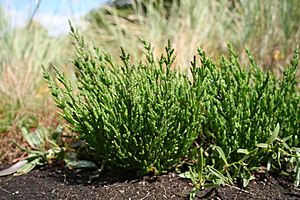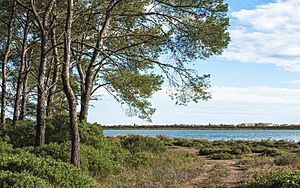Salicornia europaea facts for kids
Quick facts for kids Salicornia europaea |
|
|---|---|
 |
|
| Scientific classification | |
| Genus: |
Salicornia
|
| Species: |
europaea
|
| Synonyms | |
|
List
|
|
Salicornia europaea, often called common glasswort or just glasswort, is a special type of flowering plant. It grows in salty places, like beaches and salt marshes. This plant is an annual, meaning it lives for only one year. It belongs to the plant family Amaranthaceae.
Glasswort is a succulent plant. This means it stores a lot of water, making it look a bit see-through, like glass. That's how it got the name "glasswort"! Some people call it "pickle weed" or "marsh samphire". Others know it as "chicken toe" because of its unique shape, or simply "saltwort".
Contents
What Does Glasswort Look Like?
Glasswort plants are usually small. They have bright green stems that look like they have joints. When autumn arrives, these plants change color to red or purple. Their leaves are tiny and look like scales. Each plant also produces small, fleshy fruits that hold a single seed.
Like many plants in its group, Salicornia uses a process called C3 carbon fixation. This is how it takes in carbon dioxide from the air to make its food.
How People Use Glasswort
For a long time, the ashes from glasswort and other salty plants were very important. These ashes, called barilla, were used to make soda ash. Soda ash is a key ingredient for making both glass and soap.
However, in the 1800s, a new way to make soda ash was invented. This new method, called the Leblanc process, was industrial. It meant people no longer needed to burn plants to get soda ash.
Eating Glasswort: A Salty Treat
Salicornia europaea is a plant you can eat! You can enjoy it cooked or even raw. In the UK, it's one of the plants known as samphire. The name "samphire" might come from the French phrase herbe de Saint-Pierre, which means "St. Peter's herb".
People usually cook samphire. They often coat it in butter or olive oil. Because glasswort naturally has a lot of salt, you don't need to add any salt when cooking it. Just boil it in plenty of water. Once cooked, it looks like seaweed. Its taste and texture are similar to young spinach stems, asparagus, or artichoke hearts. Samphire is often served with fish or seafood, as it has a fresh, sea-like flavor.
Health Benefits of Glasswort
Scientists are studying glasswort for its possible health benefits. In South Korea, one company has found a way to get low-sodium salt from Salicornia europaea. This plant naturally collects salt. The company believes this plant-based salt can help people with high blood pressure. It might also help with fatty liver disease by lowering the amount of salt they eat.
This company has also made a special powder from glasswort. This powder has healthy compounds called polyphenols. These polyphenols are thought to help fight arteriosclerosis, a condition where arteries harden. They might also help with obesity. Plus, using plants like glasswort could help solve food shortages around the world.
Glasswort and the Environment
Salicornia europaea is being looked at for its role in helping the environment. It's a promising plant for something called phytoremediation. This is a process where plants are used to clean up polluted soil. Glasswort can help clean up salty soils that have been contaminated with harmful substances like cadmium.
Growing Your Own Glasswort
If you want to grow glasswort, it likes light, sandy soil. It also needs a spot where it gets plenty of sunshine. You can plant samphire outdoors once there's no longer a risk of frost.
The best way to water Salicornia is with a special salty solution. You can mix 1 teaspoon of sea salt into about 1 liter of water. Glasswort grows best when the water has a certain amount of salt in it.
You can start harvesting the shoots from June to August. After August, the shoots might become too woody. Think of samphire as a "cut-and-come-again" plant. This means you can cut some parts, and it will grow back. Just make sure to wait about a month between each time you harvest.
See also
 In Spanish: Salicornia europaea para niños
In Spanish: Salicornia europaea para niños




